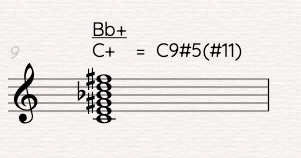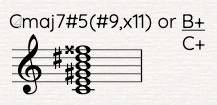The most important feature of Heptatonic Systems is the interval pattern that is present in each mode and the triad, seventh chord and upper voices that are present.
The structure of the Major scale is R,2,3,4,5,6,7. This results in this intervalic structure - Whole Step - Whole Step - Half Step - Whole Step - Whole Step -Whole Step and then Half Step back to the root.
Altering one note changes the color, character and meaning of the scale and the modes that emanate from it. In C, the triad is major, C, the seventh chord is Cmaj7 and the upper voices are 9,11&13. The structure of the Harmonic Major scale is R,2,3,4,5,b6,7.
The triad and seventh chord remain the same as in Major but the b6 gives us a b13 in the upper voices and the interval of an augmented second/minor third between the sixth and seventh degrees of the mode. This produces a profoundly different color and affects the entire character of a composition.
Juxtaposing Major and Lydian modes from the same root reveals a subtle yet distinct color difference. Let’s stretch these modes into extended arpeggios by placing the notes in ascending thirds:
Major: R,3,5,7,9,11,13 Lydian: R,3,5,7,9,#11,13
To really hear this distinction it’s best to play a major triad or a maj7 chord and then improvise a short melody using the major scale and then do it again but use the lydian mode. The mood itself is different. Note that the word mode is related to the word mood, from the Proto-Germanic root moda and related to the Sanskrit mod.
The Altered Scale
In an effort to have melodic linear sources that provided even more upper voice coloration, Charlie Parker, Dizzy Gillespie and their colleagues and followers, used heptatonic modes enharmonically to provide more than one altered ninth on a dominant seventh chord.
The extended arpeggio for the Super Locrian mode looks like this: R,b3,b5,b7,b9,b11,b13
If viewed enharmonically the b3 becomes #9, the b11 becomes 3, b5 can be #11 or b5 and the b13 can be either #5 or b13. The result is referred to as the Altered Scale, R,3,b5(or #11),#5(or b13),b7,b9 and #9 with the symbol C7alt used if taken from the Db Melodic Minor system.
Symmetrical Scales
Evidence of symmetrical scales and patterns in improvisation began appearing with the infusion of the mixture of intellect and rhythm that is referred to as BeBop. These same improvisors found that the symmetrical scales used by some early 20th century European classical composers, including Bartok, Ravel and Debussy, provided even more variation on upper voices over certain chords.
A symmetrical scale with intervals of alternating half-steps and whole steps adds not only additional colors, but the resolving tendency of this intervalic pattern pushes the melodic possibilities in non-heptatonic directions.
The Chromatic Scale, the ultimate Symmetrical Scale, 12 equal-tempered tones with a half-step in between each tone started appearing in small ways in the late baroque and then in a big way with Bach. It is, however, the other Symmetrical Scales that produce unique color combinations over conventional chords as well as providing harmonies not found in the heptatonic landscapes.
Here we see how the Half Step/Whole Step Symmetrical Diminished scale affects a dominant seventh chord with G as root: Mode: R,b2,#2,3,#4,5,6 and b7
As an extended arpeggio: R,3,5,7,b9,#9,#11,13 (G13b9,#9,#11)
So this scale can apply to any variations of a G7 with those specific voices: G7, G7(b9), G7(#9), G7(#11), G13, etc.
Perhaps the most distinctive feature about the Half Step/Whole Step Symmetrical Diminished scale is that it identical in the tones it produces as:
A Whole Step/Half Step Symmetrical Diminished scale starting a half step higher.
A Half Step/Whole Step Symmetrical Diminished scale starting a minor third above, A Whole Step/Half Step Symmetrical Diminished scale starting a half step higher than that.
A Half Step/Whole Step Symmetrical Diminished scale starting a tritone (two minor thirds above), A Whole Step/Half Step Symmetrical Diminished scale starting a half step higher than that.
A Half Step/Whole Step Symmetrical Diminished scale starting a minor third below the original scale (three minor thirds above it). A Whole Step/Half Step Symmetrical Diminished scale starting a half step higher than that.
So these would be its modes. Another way to see it is that the symmetrical diminished scales are two diminished seventh chords a half-step apart. Like diminished seventh chords in which the same four notes appear every minor 3rd, with the symmetrical diminished scale and its modes, the same eight notes appear every minor 3rd.
The Whole Tone Scale and the Symmetrical Augmented Scale
Two important scales that are both symmetrical and hexatonic are the Whole Tone Scale and the Symmetrical Augmented Scale. They are both centered on the augmented triad, and add additional voices to the triads contained within. In fact, the Symmetrical Augmented Scale produces an extraordinary amount of chord qualities from its six notes.
The Whole Tone Scale
The Whole Tone Scale is simply every other note from the Chromatic Scale. Its modes start on every whole step. It produces an augmented triad, [+], an augmented seventh chord, [7#5] and [9#5] and [9#5(#11)]. Because it is all whole steps it produces the same quality chords on every scale tone. If spread into thirds you have an augmented triad on the root and an augmented triad built on the b7.
The Symmetrical Augmented Scale
The unique structure of this hexatonic scale linearly is minor 3rd/half-step/minor 3rd/half-step/minor 3rd/half-step. This repeats every major third. The first mode then is half-step/minor 3rd/half-step/minor 3rd/half-step/minor 3rd. This also repeats every major third.
What we find is two augmented triads a half step apart. To get the full six note chord and arpeggio you can place a B+ triad on top of a C+ triad.
OK, what is with this double-sharp 11? While you do see it in some very exotic heptatonic scales we realize that Fx, (F double-sharp) is enharmonically the same as G, the fifths. We also see that there is already a #5 present, so we have the possibility of two different 5ths. Or a 5th and a flat 13. It's necessary to view this scale enharmonically to see all its possibilities.
This way we can view the #5 alternately as a b13 (b6), the #9 (#2) as a b3 and the x11 as a natural 5. Triad-wise we then have a C ,C+ and Cm! For seventh chords there are Cmaj7, Cmaj7#5 and Cm(maj7), and even Cm(maj7)#5 if you want.
Possible chords with upper voices can be Cmaj7(#9,b13), Cmaj7#5(#9) and all of these chords repeat with a new root every major 3rd, E, E+, Em, Ab, Ab+, Abm, etc. Starting on the other three notes, D#/Eb, Fx/G and B will give you inversions of the already mentioned chords.
For the very same reason that heptatonic modal names are used, other scalar designations can be applied to define moving harmonies. Below we have Symmetrical Scales and their Modal Symbols.
These are listed as:
Mode: Half Step/Whole Step Modal Symbol: C h/w sym dim
Symmetrical Diminished Scale
Half Step/Whole Step: C h/w sym dim
Whole step/Half Step: Db w/h sym dim
Whole Tone Scale
Whole Tone: C w/t
Symmetrical Augmented Scale
Minor Third/Half Step Symmetrical Augmented: C sym aug
Half Step/Minor Third Symmetrical Augmented: Eb h/min3 sym aug
Next: Chords and slash-chords derived from Symmetrical Scales and a glance at the usefulness of Bartok’s Pole Theory in relation to composing for improvisors.
Copyright © 1993-2023 Jack DeSalvo











